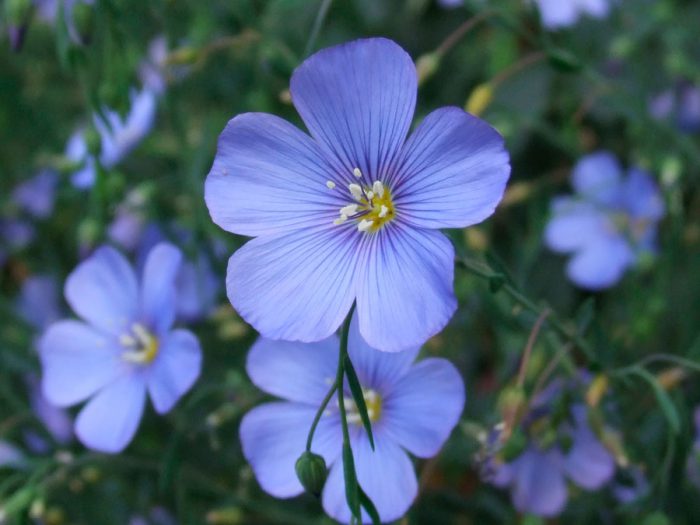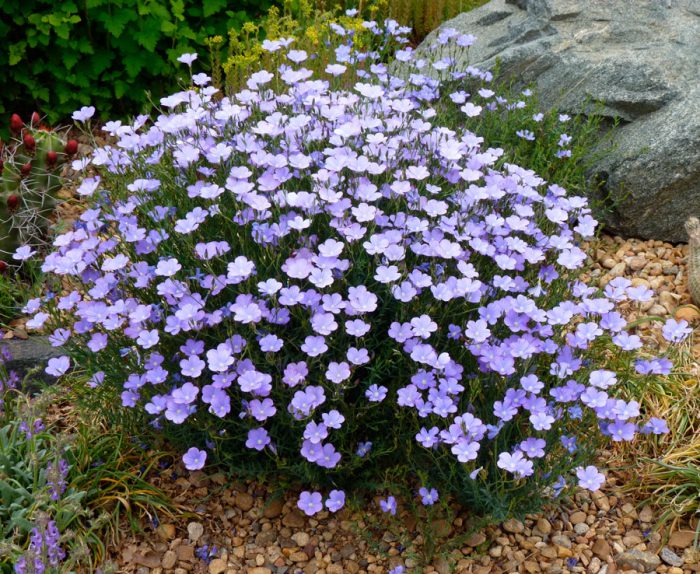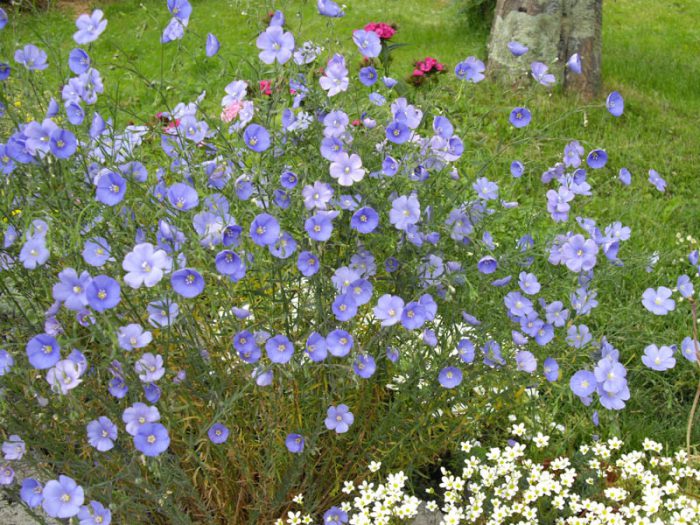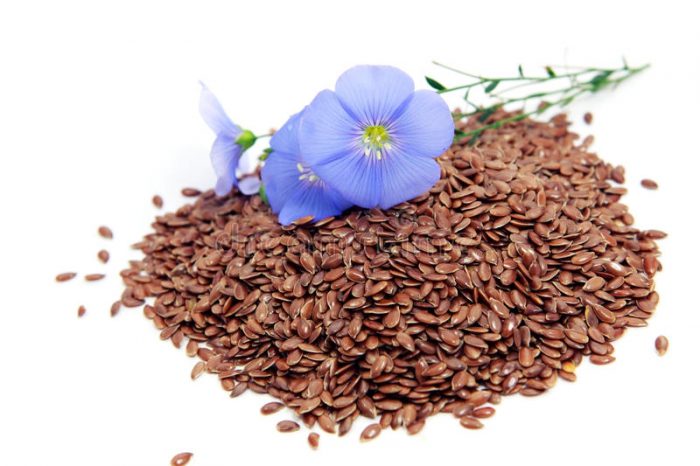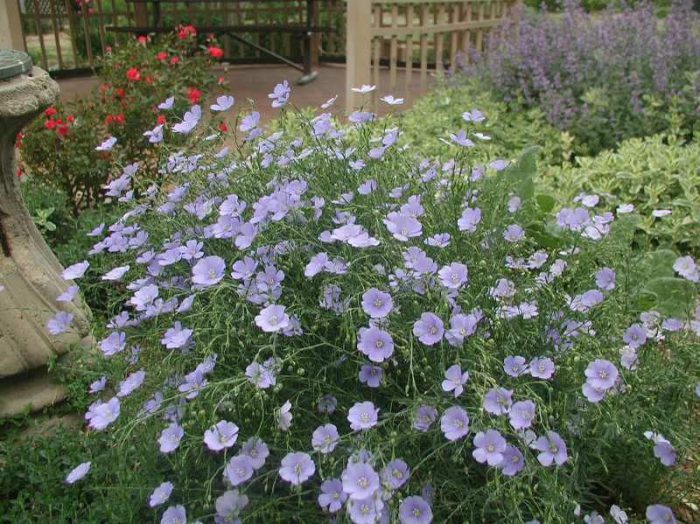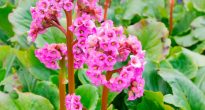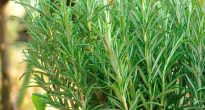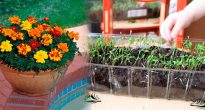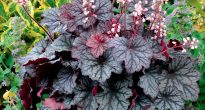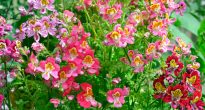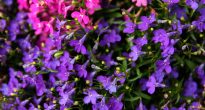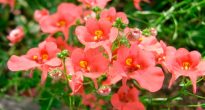A gardener, choosing flowers for growing in the garden, often undeservedly bypasses perennial flax. The fact is that this flower has long been considered an excellent decoration for the house, which, moreover, can protect it. This culture is distinguished by its unpretentiousness, but at the same time it has a relatively high decorative effect, since it has very beautiful flowers. There is an opinion that the flowers of this plant must be painted blue, but this is far from the case.
Content
Description of perennial blue flax
Flax is a herbaceous plant. This genus unites about 200 of the most diverse species. Often, flax is not very large bushes, the height of which does not exceed 50 centimeters. Despite the fact that the shoots of such a culture are very thin, they are relatively powerful. Flowers are of various sizes (from very large to small). They can be painted white, bluish or red-pink.
This plant is widely cultivated by gardeners in the middle lane. It feels great in a temperate climate, so it can be found in nature in Africa, North America, and also in some regions of Asia and Europe.
Types and varieties of flax
Among all known types and varieties of flax, the following are the most popular among gardeners:
- Oilseed... Such a decorative variety is very often cultivated indoors. Most often, such a plant is grown in order to obtain flax seeds, which are distinguished by their high nutritional value, as well as healing properties. As a rule, the bush does not exceed 0.3 meters in height. The flowers are not very large. They can be colored yellow, bluish, or even red.
- Decorative... This species is distinguished by its unpretentiousness, so even a person far from gardening can grow it. In addition, you should know that a durable fabric is made from various decorative varieties of flax, used for sewing clothes, linen, etc.
- Large-flowered... This flax variety has been grown in mid-latitudes not so long ago. But in this short time, he managed to become one of the most popular varieties among gardeners. The height of a medium-sized bush, as a rule, does not exceed 50 centimeters. The flowers of this variety are very large, and they can be painted in a variety of color shades.Such a plant is perennial, if it is provided with favorable conditions for growth, then without transplanting in the same place it can be grown for five years.
- Perennial flax... This variety, in comparison with the rest, is the most widespread. Very attractive bushes of such flax are used to decorate borders, flower walls, etc.
Planting flax in open ground
Flax is not very demanding on growing conditions, which greatly facilitates the choice of a suitable place for planting it. However, if you want it to grow and develop within normal limits, then for planting, choose an exclusively open sunny area, on which no shadow should fall either from shrubs with trees, or from various buildings. If there are very few sunny days in your area, then you are unlikely to be able to grow perennial flax.
Also, this plant is undemanding to the composition of the soil. It can be grown in almost any soil except swampy soil. For planting, choose an area with light soil where the groundwater is relatively deep. Perennial flax can be grown quite successfully on slightly steep slopes.
Sowing seeds of perennial flax varieties is recommended to be carried out in boxes at home. If you live in a region with a relatively mild and warm climate, then you can sow seeds in open soil. It is not recommended to bury them in the ground. Seeds are evenly distributed over the surface of a previously prepared area, and then the crops are moistened with water from a sprinkler. It is possible to sow seeds in open soil both in spring (when the weather is warm and the daytime temperature will be about 20 degrees) and in autumn (you need to catch it before the cold weather, while the average daytime air temperature should be at least twenty degrees).
If you are planning to sow perennial flax in open soil, do not forget to take the cold factor into account. Sowing is strictly prohibited on a rainy or wet day. The area with crops must be covered with a not very thick layer of soil, then they are insulated in the same way as most garden flowers.
Flax propagation
There are several ways that flax can be propagated quite successfully. They will be described in more detail below.
Generative (seed) way
You can grow such a flower from seeds in containers. And you can sow seeds directly into open soil, such sowing is carried out in the spring or autumn (before winter) time. All you need to do is spread the seeds evenly over the surface of the soil, and then they are simply sprayed with a spray bottle. They should not be buried in the ground. It is possible to sow perennial flax seeds into the soil, if necessary, in the summer.
If you decide to sow seeds in containers, then you should know that grown seedlings cannot be transplanted into open ground, because they get very sick after such a procedure and often die. When the seeds have been sown, the containers are immediately transferred to fresh air.
Dividing the bush
If you grow two-year-old flax on your site, then it can be propagated by dividing the bush. In the middle of spring or in August after the plant has faded, the bush is divided into several parts. The plots should be immediately planted in open soil, keeping a distance of 0.2 m between them. They should be watered regularly and often enough, as well as protected from direct sunlight.
Blue flax care
If you want flax flowering to be as effective as possible, and he himself grows and develops normally, he will need to provide good, proper care. The features of perennial flax care will be described in detail below.
For normal growth and development, such a flower needs a sufficient amount of water.In this regard, it must be watered systematically. However, make sure that no water stagnation occurs in the soil.
Please note that flax reacts extremely negatively to liquid stagnation in the soil. Depending on the air temperature and rains, flax is watered on average 1 or 2 times every 7 days. It is important that the soil under the bushes is slightly moist at all times. After the fall begins, watering is gradually reduced, and then they must be stopped altogether.
It is also necessary to weed in a timely manner, since the thickening of the planting and weeds negatively affect the decorativeness of flax.
Often you will not have to feed perennial flax, which greatly facilitates caring for it. Before proceeding with sowing seeds in open soil, it is necessary to add not a very large amount of organic matter to it, and also add a little potash fertilizer. During the growing season, it is recommended to feed flax at least two more times, and you need to use liquid fertilizing. It is recommended to feed such flowers only after they have been watered.
The gardener does not have to deal with a bunch of diseases and pests, because flax has a fairly high resistance to them. However, in some cases, a flax flea can settle on the bushes. If you decide to fight it with various folk methods, then keep in mind that they will all be ineffective. Therefore, without wasting time, process the infected bushes with specially designed chemicals.
In order for such a very beautiful and rather unusual flower to grow normally in your garden, as well as to ensure the most spectacular flowering, it should be planted next to only those plants that have a very similar development pattern, and also need the same growing conditions ...
Linen in landscape design
Perennial blue flax is quite popular among gardeners. Such a flower is recommended for use in a variety of group compositions, for example: in mixborders, rock gardens, flower beds, and also in very picturesque borders.
It has been noticed that flax goes well with those crops that need a lot of sunlight and have a fairly high drought tolerance. Perennial flax has excellent growth when planted on a Moorish lawn. It is recommended to plant it together with such beautiful flowers as marigolds, clover, chamomile and cornflowers.
Perennial blue flax certainly deserves attention from gardeners. Its advantage is that it is not too picky about growing conditions, it is relatively easy to care for, and this flower is also very beautiful.


Watch this video on YouTube

